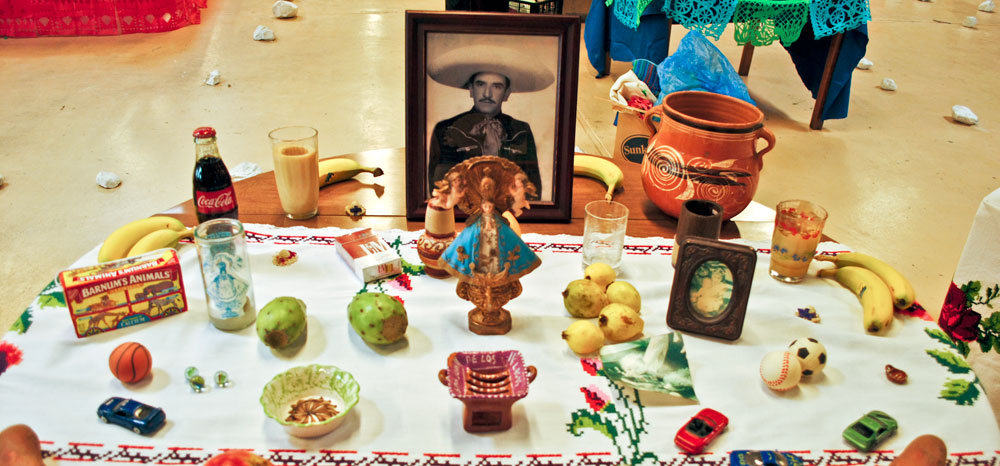EL PASO – Carefully placing her deceased father’s framed portrait on a round table covered with a Spanish style tablecloth, Lorena Andrade neatly arranged his favorite things such as the sugar cane, bananas, tunas and lemons, a pack of L&M cigarettes and a Coca Cola glass bottle.
“With the candles and the scent of the flowers they can find you,” she said. “You put food that they like to eat that way they would want to come back and, you know, sit down and talk and eat together. It’s a way for them to come back to visit.”
Like Lorena many people gather at Mercado Mayapán to celebrate Day of the Dead, known to Latinos as Día de Los Muertos. It’s a day and a month when mourners remember their lost loved ones and place ofrendas (offerings) on altars in remembrance and to welcome the departed.
Decorations of colorful papel picado adorn most of the building, giving it a festive air. November 2nd gives the living a chance to celebrate the lives of the deceased with stories, memories and plenty of pan de muerto.
Lorena also places a few car toys, marbles, a box of animal crackers, a sweet potato and a pomegranate in respect for her deceased nephew. She briefly says that it’s a day to remember our loved ones since they also made history and contributed to the community.
A nostalgic mood emerges since the backdrops of many altars consist of black and white photographs. At least one calavera (skull) adorns the altars since death is a constant reminder of why all gather here. This is one of the most popular holidays in Mexico where the idea of this celebration is to accept death and not fear it.

Lorena Andrade's altar in memory of her father and nephew. (Elvia Navarrete/Borderzine.com)
The aroma of incense and Cepazuchitl or Marigolds used to decorate the many altars fills the Mayapán market. Symbolically Cepazuchitl is recognized as the flower of death because once it’s cut it dies very quickly. It is also said that the scent attracts the deceased spirits and as a result white candles are quickly lighted to help them light the way. Favorite dishes are made to welcome the spirits and in some cases pillows are placed for them to rest after the long journey.
Little shops surround an area of the market where you can find anything from calacas (skeletons) to traditional jewelry.
Francella Salgado arrives early to set up her Día de Los Muertos style art work. Handmade and hand painted calavera shaped jewelry sit on top of her display table where she also sells tall vibrant colored candles and prints of original paintings sit in frames. Her artwork is based on her heritage, she says. “I make the darker imagery more beautiful it’s not just about death I think there’s also a beauty aspect to it.”
Spectators pay the market a visit and get a chance to reconnect to an old tradition that might be fading away. Guillermo is one of those spectators who finds this event to be the real thing since he thinks that El Paso is losing some of its authenticity. For him this becomes more of a unifying experience, especially for the 85 percent Hispanic, Mexican and Chicanos who live here.
“I think it’s a really important event, here in El Paso. It brings together families in a lot of different ways because it’s important to recognize our ancestors and not be separated from them because they are part of our strength,” he says.
Ultimately this is a representation of who Latinos are and it gives others an opportunity to better understand Latin culture as well.

